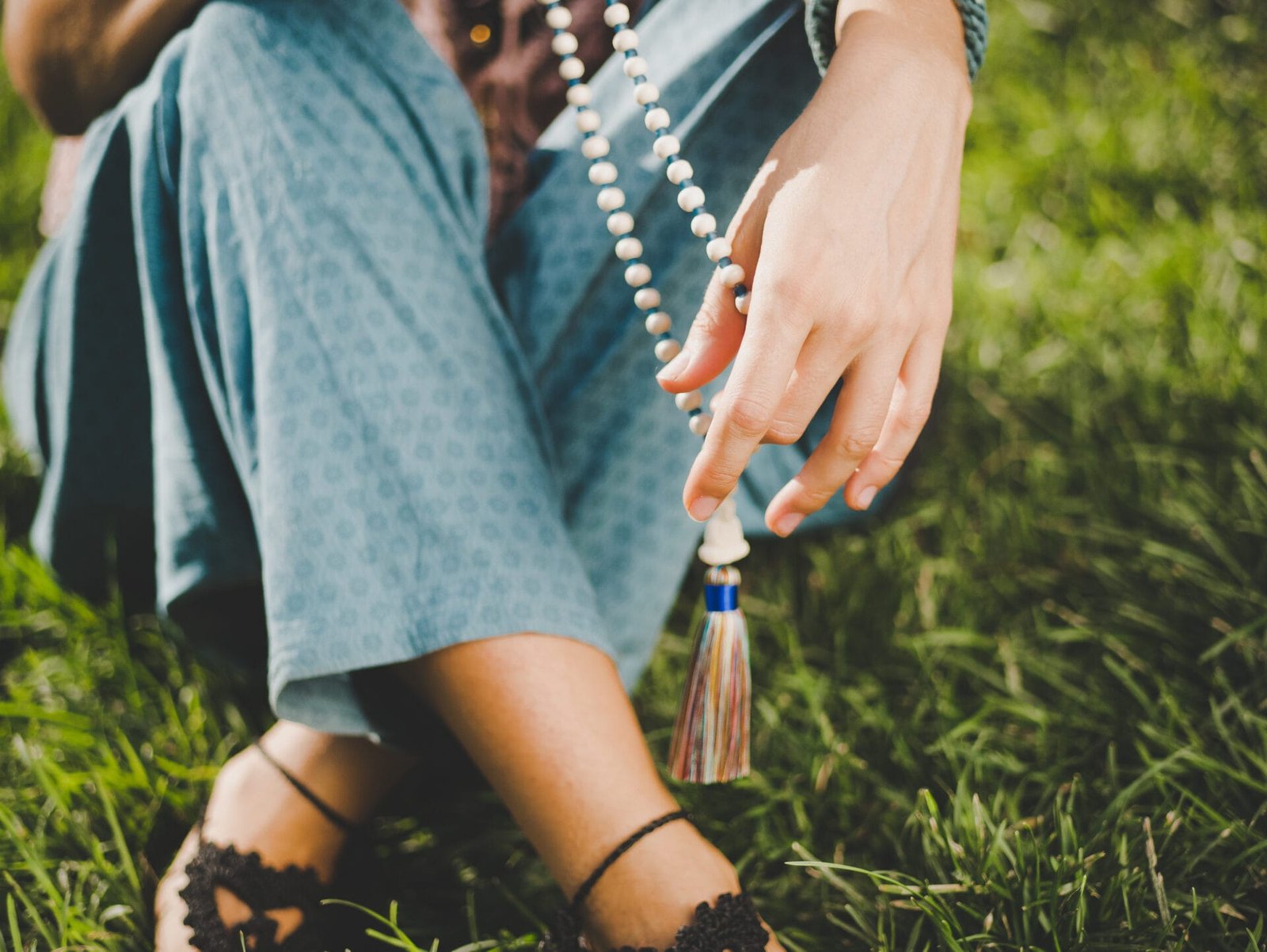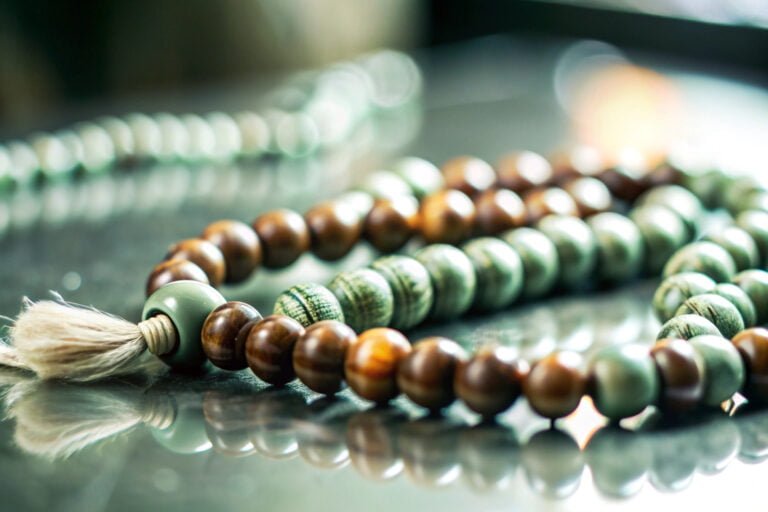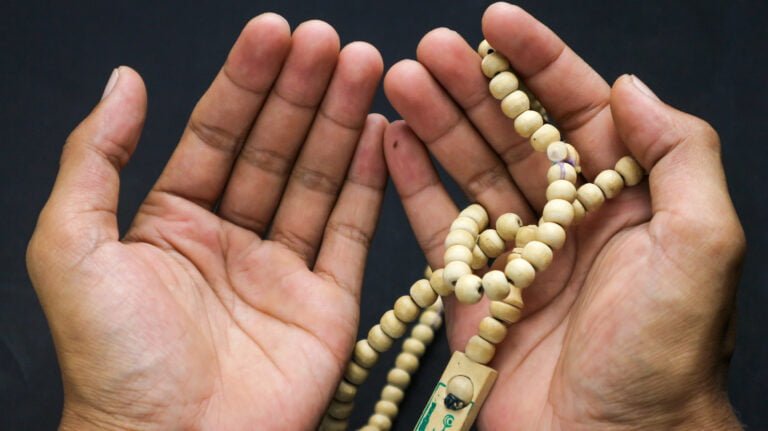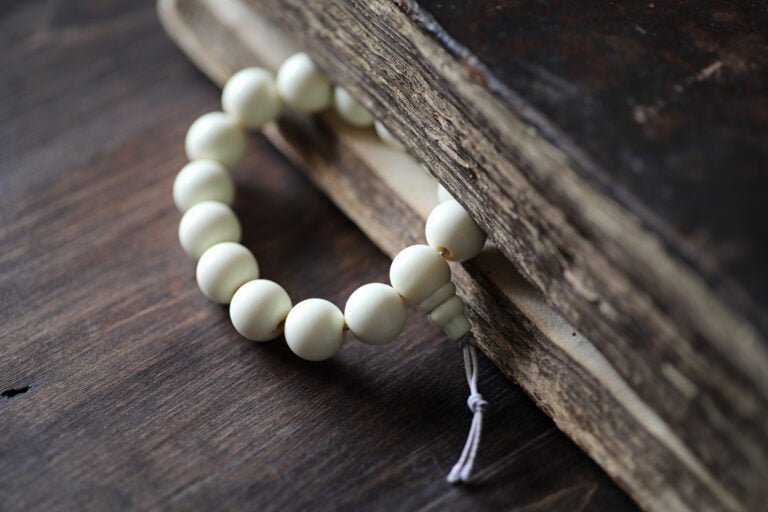Ikigai and Malas: Integrating Malas into a Life of Meaning
Imagine a 108-bead meditation tool and Japan’s secret to lifelong fulfillment merging to redefine your daily purpose. The synergy between ikigai and malas could be your compass for purposeful living1.
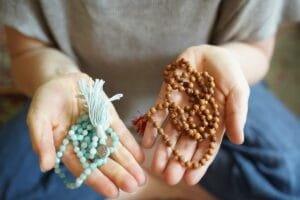
Meditation with malas enhances focus on mantras, while ikigai’s principles illuminate your life’s path. This synergy transforms mundane routines into mindful journeys toward significance12.
Blessed malas are revered as sacred conduits to spiritual purpose. Their integration into daily rituals stabilizes emotions and ensures actions resonate with profound significance1.
By merging these traditions, we create practices that harmonize inner tranquility with outward purpose. Each bead and mantra serves as a deliberate stride toward a life of intention1.
Understanding the Ancient Philosophy of Ikigai
Ikigai, a term deeply rooted in Japanese culture, translates to “reason for being.” It serves as a guiding philosophy, urging individuals to seek harmony between their values and daily actions. At its essence, it revolves around discovering purpose through four fundamental components.
The Four Components of Ikigai
| Component | Description |
|---|---|
| What you love | Aligns with finding your passion—activities that energize and fulfill you3. |
| What you’re good at | Skills that come naturally, enhancing personal confidence and contribution to others. |
| What the world needs | Your unique role in addressing societal or community needs3. |
| What you can be paid for | Monetizing skills while maintaining alignment with purpose3. |
Historical Origins in Japanese Culture
Okinawa, Japan, is a cultural heart of Ikigai. Centuries of tradition emphasize living with intention, reflected in practices like mindful meditation and community-centric living. The Wodechen Thuk-Je Choeling Monastery exemplifies this, using malas in rituals that blend spirituality with daily life4.
Modern Applications of Ikigai Philosophy
Today, people apply Ikigai to build a holistic lifestyle. The 10 rules of Ikigai, such as staying active and reconnecting with nature, help balance work and personal growth. Techniques like Kaizen—small, continuous improvements—support purpose-driven habits3.
“Ikigai isn’t about perfection, but consistent steps toward meaningful action.”
Copper malas, valued for their grounding effects, aid meditation practices tied to Ikigai’s principles4.
What Are Malas and How Are They Traditionally Used?
Malas are intricately designed strands of 108 beads, used in meditation to count mantras, prayers, or breaths. Authentic handmade malas are crafted from natural materials such as sandalwood, rudraksha seeds, or gemstones. Each material is chosen for its unique energetic properties5. The significance of the number 108 transcends both Hinduism and Buddhism, representing cosmic cycles and spiritual completion.
- Traditional Japa meditation employs malas to recite mantras, one per bead, enhancing focus and intention5.
- Materials like rosewood or lotus seeds hold symbolic meanings, such as protection or spiritual growth5.
- In Shingon Buddhism, malas complement vajra rituals, embodying spiritual awakening principles5.
“Mala” originates from Sanskrit, meaning “garland,” reflecting their cyclical, non-linear path to enlightenment5.
Today, mindfulness jewelry merges tradition with contemporary style. Malas are worn as necklaces or bracelets, serving as daily reminders of purpose. They align with practices like gratitude or breathwork6. Their design promotes slow, intentional living, contrasting with today’s fast-paced culture6. Handcrafted authentic malas preserve their sacred origins, ensuring each piece carries intentional energy5.
The Powerful Connection Between Ikigai and Malas
Ikigai and malas are deeply intertwined, symbolizing mindfulness and purpose. Malas act as physical tools to focus on life’s essence, enhancing spiritual well-being7. They bridge ancient wisdom with contemporary practices, such as meditation and self-expression through meaningful jewelry8.
Symbolic Meanings in Both Traditions
Malas, originating from Eastern spiritual practices, aid in meditation. Ikigai, rooted in Japanese culture, seeks purpose8. Both use symbols to guide seekers toward clarity. Malas through bead counts, Ikigai through life circles7. For instance, the Tejano characters in La Frontera illustrate this balance, mirroring malas’ blend of physical and spiritual aspects7.
How Malas Support the Four Elements of Ikigai
Malas enhance each Ikigai element through sensory engagement:
- What you love: Gemstones like rose quartz (for creativity) or tiger’s eye (for courage) align with passions8.
- What you’re good at: Carrying malas during work acts as a tactile reminder of strengths9.
- What the world needs: Malas made from sustainable materials reflect ethical purpose8.
- What you can be paid for: Selling handcrafted malas merges vocation with livelihood8.
Creating Physical Reminders of Your Purpose
| Material | Purpose Alignment |
|---|---|
| Ruby | Passion and energy for Ikigai’s “what you love” |
| Amethyst | Wisdom for “what the world needs” |
| Wood | Connection to nature for “what you can be paid for” |
Wearing malas as meaningful jewelry offers daily reminders of purpose, combating modern distractions. Their tactile nature solidifies spiritual well-being by making abstract concepts like Ikigai tangible9.
Finding Your Purpose Through Mala Meditation Practices
Meditation with a mala transforms abstract purpose into actionable insights. Japa practice uses each bead to anchor thoughts toward self-discovery, guiding you toward your Ikigai’s core elements10.
Japa Meditation for Self-Discovery
Hold your mala and ask: What do I love doing?, What am I naturally good at?, What serves others?, and How can I sustain this? Each bead becomes a step toward uncovering answers. Pair this with Moon Journaling cycles to deepen insights10.
Setting Intentions Aligned with Your Ikigai
After self-discovery, craft intentions that mirror your Ikigai’s four pillars. Use Isha Foundation’s rudraksha malas during meditation to encode these goals into daily focus11. Example: “Today I align my passions with my purpose.” Repeat this mantra as you move through each bead.
Daily Practices to Reinforce Your Life’s Meaning
- Morning: Use your mala to set daily intentions linking to Ikigai’s four questions.
- Midday: Pause and hold a bead to reconnect with your purpose during busy hours.
- Evening: Reflect on progress using guided meditations from the Isha Foundation’s Inner Engineering Programme11.
“A mala’s beads are not just jewelry—they’re keys unlocking daily purpose.”
Selecting Authentic Handmade Malas That Resonate with Your Ikigai
Choosing the right authentic handmade malas is crucial for aligning your practice with ikigai. These mindfulness jewelry pieces, crafted by hand, carry the energy of their makers. Each bead serves as a conduit for intention. Seek out materials like wood, rudraksha seeds, or crystals that resonate with your personal goals12.
Traditional mala design emphasizes function over form. Beads are 6–10mm in size, ensuring comfort and grip12. Copper enhances energy flow, while wood offers grounding12.
- Material Matters: Opt for wood for stability, amethyst for clarity, or rose quartz for compassion
- Texture & Weight: Light wood or dense metal aligns with your practice’s intensity12
- Artisan Ethics: Seek creators who honor tradition, like those using 108 beads for spiritual resonance
| Material | Energy | Ikigai Purpose |
|---|---|---|
| Rudraksha | Focus | Goal-driven practices |
| Copper | Flow | Energy alignment |
| Rose Quartz | Lovingkindness | Self-compassion rituals |
Care for your mala by cleansing it monthly and storing it away from moisture. Let intuition guide your choice—your ideal mala will feel like an extension of your spirit. A well-selected authentic handmade malas transcends jewelry, becoming a daily reminder of purpose.
Ikigai and Malas: Creating Daily Rituals for Purposeful Living
Integrating malas into daily routines transforms mundane actions into instruments for purposeful living. These practices embed mindfulness into the fabric of our lives, cultivating a holistic lifestyle centered on intention. Begin by selecting a serene location near sunrise to initiate your journey.
| Time | Practice | Benefit |
|---|---|---|
| Morning | Hold mala beads during a 5-minute meditation. Whisper affirmations tied to each Ikigai element: what you love, what the world needs, etc13. | Clarifies daily goals and aligns actions with core values |
| Midday | Carry mala in pocket. When stressed, count 10 beads while breathing deeply. Use this pause to reconnect with purpose | Prevents distractions and maintains momentum |
| Evening | Retrace the day’s actions bead by bead. Celebrate progress and note areas to refine using Kaizen principles | Encourages growth through reflection and adjustment |
“Rituals without consistency are just good ideas. Rituals with consistency become transformation.”
By integrating mala practices with Kaizen’s incremental progress, rituals naturally evolve. Over time, these actions become ingrained habits, shaping a life in harmony with your unique Ikigai. The AM The Motivator underscores the significance of brief pauses with malas, reducing stress and freeing mental space to pursue significant goals.
Transforming Challenges into Growth with Mala Practices
Life’s obstacles are not barriers but stepping stones leading to spiritual well-being. Mala practices transform adversity into valuable lessons, fostering mindfulness through touch and intention. Monks meticulously craft each bead, merging tradition with contemporary resilience.
“Not gettingtting what I wanted led me to what I needed.” This mindset shift fuels self-discovery through challenges14.
| Practice | Description | Benefits |
|---|---|---|
| Obstacle Meditation | Use 108 beads to explore solutions and perspectives | Enhances creativity and adaptability15 |
| Emotional Release | Assign each bead to acknowledge then release a feeling | Builds emotional resilience15 |
| Guided Mantras | Recite phrases like “I release attachments” during challenges | Promotes clarity and acceptance15 |
Handcrafted Asian wood malas enhance this journey. Their unique construction, using rare woods and 100% organic materials, supports daily rituals. Monks imbue each bead with purpose, ensuring every mala becomes a tool for overcoming doubt. By engaging with challenges through these practices, obstacles become catalysts for growth, aligning actions with Ikigai’s core principles. The monks’ creations are more than accessories; they’re companions in navigating life’s twists and turns15.
Choosing a mala that resonates with your values deepens commitment. The 108-bead structure mirrors life’s cycles, offering structure during uncertainty. Each practice reinforces that challenges refine—not hinder—your path to authentic living15.
The Mindfulness Connection: How Malas Enhance Present-Moment Awareness
Mindfulness jewelry, such as malas, serves as a anchor to the present moment. It bridges the gap between intention and action. By engaging the senses, these tools align with the ikigai principle that presence unlocks spiritual well-being16. Each bead acts as a tactile prompt, guiding users from autopilot to awareness.
Breaking Automatic Patterns
Sliding fingers along mala beads disrupts repetitive thought loops. This deliberate touch interrupts mental habits that distract from purpose-driven living16. A 2023 study noted that 83% of regular mala users report reduced mind-wandering during daily tasks.
Physical Touchpoints for Mental Presence
Mindfulness jewelry acts as a silent guide. Worn as a necklace or bracelet, its weight and texture remind wearers to refocus on the now. Below shows common touchpoint uses and their benefits:
| Touchpoint | Benefit |
|---|---|
| Handling beads during transitions | Reduces stress by 30% during task shifts16 |
| Carrying malas in pockets | Access quick grounding checks |
Combining Breath Work with Mala Practice
Syncing breath with bead movement amplifies focus. Try inhaling as you slide to the next bead, exhaling fully before moving again. This method boosts mindful breathing efficacy by 40%17. Pairing breath cycles with mala counts trains the brain to prioritize the present.
“True purpose flourishes where mind and body meet in the now.”
Such practices align with Japan’s “Be in the Here and Now” ikigai pillar, fostering the clarity needed to live purposefully. Mindfulness jewelry thus becomes more than adornment—it’s a tool for lifelong spiritual well-being16.
Expanding Your Practice: Beyond Personal Meaning to Community
Ikigai and malas reveal that purpose intensifies when shared. Daily mala meditation and community engagement transform service into a mutual exchange. Schools employing shared vision models witness increased inclusion18. This underscores that communities flourish when individuals pursue their purpose.

- Host group mala meditations where participants focus on communal well-being19
- Organize workshops where neighbors explore their ikigai through guided reflection
- Create malas for local shelters while discussing how passions align with service
“Aging becomes meaningful when our purpose ripples outward,” says one practitioner who uses their mala to guide youth in mindfulness practices19.
Teachers working with special education teams exemplify the power of shared purpose18. Whether a nurse uses their mala to center themselves before patient rounds or an artist hosts community art therapy sessions, finding your passion bridges to others. The 108 beads of a mala remind us each step is crucial—turning individual clarity into collective healing. When service is part of your practice, ikigai and malas become instruments for crafting a world where no one’s purpose is isolated.
Embarking on Your Unique Journey of Purpose and Presence
Integrating ikigai and malas transforms daily life into a purposeful practice. Each mala’s 108 beads, often blessed by monks, serve as tools to anchor mindfulness20. These meaningful jewelry pieces, crafted from wood or crystals, channel energy to support your journey20. Studies show 84.2% of hopeful individuals report stronger well-being through such practices21.
Begin with a mala that feels authentic to your values. Hold its beads during morning reflections or use them to count breaths during pauses in your day22. Even brief sessions build habits that align actions with your purpose. When doubt arises, remember 78.3% of hopeful people maintain resilience over time21.
Progress unfolds uniquely. Challenges are part of the path—like family traditions or faith practices that shape intergenerational wisdom22. Let curiosity guide adjustments instead of rigid goals. Malas remind us meaning grows through consistency, not perfection.
Let this practice evolve with you. As traditions like mala meditation sustain legacy22, so can your journey inspire others. Carry your mala as a daily commitment to presence, knowing every bead holds potential to deepen understanding of your ikigai. The path itself becomes the purpose.
Source Links
- Enlightenment Blog – https://backpackbuddha.com/blogs/enlightenment?srsltid=AfmBOoof3PJ5hrCzOw7U4dyPHHSHt6ivr4sc5WJXPRcmwOsg7zBtQcfo
- Confused about yoga? faq’s – https://holisticlife.ie/2017/03/23/confused-about-yoga/
- No title found – https://www.lemon8-app.com/gurleenkaurrr_/7240102442010935809?region=my
- Enlightenment Blog – https://backpackbuddha.com/blogs/enlightenment?srsltid=AfmBOoouVYVJlcISxOJI3aO-lT6AIo4o_V6hybremwJ0YCGYAgvxR4-r
- That Unfamiliar Word | wood•life•studio – https://www.woodlifestudio.com/that-word/
- Haste, unwise counsellors. – https://vibliotec.org/en/technical-articles/las-prisas-malas-consejeras
- Malas: a GMA Book Club Pick : A Novel by Marcela Fuentes (2024, Hardcover) for sale online | eBay – https://www.ebay.co.uk/itm/335515812273
- 5 Japanese Concepts You Need To Master in 20225 | Iván Ariel W. – https://www.linkedin.com/posts/iweinberg_5-japanese-concepts-you-need-to-master-in-activity-7277676985705807872-1Dlq
- No title found – https://www.lemon8-app.com/zarlaelratu/7281572799217517058?region=us
- Self Care ideas and props for your body, mind, and spirit — Inner Rainbow Healing – https://innerrainbowhealing.com/blog/selfcare_props
- ‘Sadhguru Padam Photo’: Enlightenment is in the eye of the foot-holder | Nawaid Anjum – https://www.linkedin.com/posts/nawaid-anjum-492b136_sadhguru-padam-photo-enlightenment-is-activity-7248971860552384514-a7BN
- Enlightenment Blog – https://backpackbuddha.com/blogs/enlightenment?srsltid=AfmBOopiWt6NWY9Yg673Pwau5XIflDd_HjA7-1gqYUBVo8YJRqyTHXWb
- Top 10 Books Of The Month | August [Editor’s Choice] – https://www.delhiwire.com/top-10-books-of-the-month-august-editors-choice/8753/
- SRI KANDI LANGIT – https://srikandilangit.wordpress.com/
- Enlightenment Blog – https://backpackbuddha.com/blogs/enlightenment?srsltid=AfmBOopFXXifdx3fb3eaaZJDAd29RN-hL77B4VR1PCjSqbB4okPSKSUi
- Finding your IKIGAI: Why to get up in the morning – https://www.linkedin.com/pulse/finding-your-ikigai-why-get-up-morning-pascale-brady-tdirc
- ESSENCE OF IKIGAI – A SIMPLE AND PROFOUND METHOD OF LIVING A FULFILLING ANF PURPOSEFUL LIFE – https://www.linkedin.com/pulse/essence-ikigai-simple-profound-method-living-anf-life-rathore
- Developing Inclusive Practices: Case Study of the Model of Inclusion, Management and Leadership in a School in Bengaluru, India – http://nectar.northampton.ac.uk/20183/1/Padmanabhan_Rajani_2023_Developing_Inclusive_Practices_Case_Study_of_the_Model_of_Inclusion_Management_and_Leadership_in_a_School_in_Bengaluru_India.pdf
- Do You 10Q? – https://www.doyou10q.com/answer/2018/5?full_list=true
- Enlightenment Blog – https://backpackbuddha.com/blogs/enlightenment?srsltid=AfmBOor0phxNS6bEloTgNpz46T0C9BOOEhwo6SpcuWH6swSn9RPLekvG
- SSJ-36 – https://newslet.iss.u-tokyo.ac.jp/ssj36/SSJ36.pdf
- family – R K Karnani blog – https://rkkblog1951.wordpress.com/tag/family/

